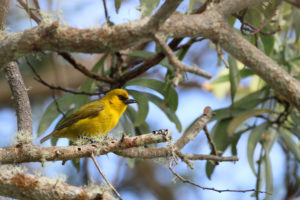Land Board Approves Plan to Protect Native Species
The State Board of Land and Natural Resources (BLNR) has agreed to a Kamehameha Schools (KS) plant to help provide recovery and protection for native birds, bats and plants on nearly 33,000 acres of lands at Keauhou and Kīlauea on Hawai‘i Island.
The 50-year-long Safe Harbor Agreement (SHA) is a cooperative agreement between KS, the Department of Land and Natural Resources and the U.S. Fish and Wildlife Service. It establishes baseline populations for threatened and endangered species, outlines critical habitat needs for these species, and specifies land-use practices to help increase population numbers.
The agreement covers seven native birds including the Hawai‘i Creeper, the Hawai‘i ‘Ākepa, the Hawaiian Hawk (‘Io), the Hawaiian Crow (‘Alalā) and the Hawaiian Goose (Nēnē). It also includes the Hawaiian Hoary Bat (‘Ōpe‘ape‘a) and 25 plant species.
In addition to the SHA, the BLNR approved an Incidental Take License which provides mitigation measures in case land-use practices result in the loss of any species covered under the agreement. The ultimate goal of the license is to increase populations of threatened and endangered native species.
Jackie Gaudioso-Levita, the ‘Alalā Restoration Project Coordinator for the DLNR Division of Forestry and Wildlife said, “The momentous finalization of this large-scale Safe Harbor agreement will particularly benefit imperiled species, such as the ‘Alalā, which will be reintroduced on State land adjacent to the Keauhou-Ka‘ū Kamehameha Schools parcel, thereby in-part, protecting and managing potential ‘Alalā habitat for decades to come.”
“This agreement strengthens Kamehameha Schools’ ability to steward these lands in a manner that fosters healthy habitats for species fighting to survive,” said Kamehameha Schools CEO Jack Wong. “As we work toward a thriving lāhui, the cultural connection to ‘āina that is healthy and vibrant becomes much more important for Native Hawaiians and all the people of our State.”
KS Ecologist Nāmaka Whitehead said that Hawaiians derive their identity form the ‘āina.
“Healthy, functioning native ecosystems are the foundation of Hawaiian cultural identity and wellbeing,” said Whitehead. “Stewarding our ʻāina to be more resilient ensures that future generations will continue to have a relationship with the native species and ecological processes that make us who we are.”
DLNR Chair Suzanne Case added, “The vast acreage covered by this Safe Harbor Agreement is incredibly important to the recovery and perpetuation of these vital bird, bat, and plant species. We are extremely happy to have worked out this agreement with Kamehameha Schools and in the coming decades look forward to many great stories of native species success as a result.”
The SHA was discussed and reviewed for more than a year during numerous open meetings.















